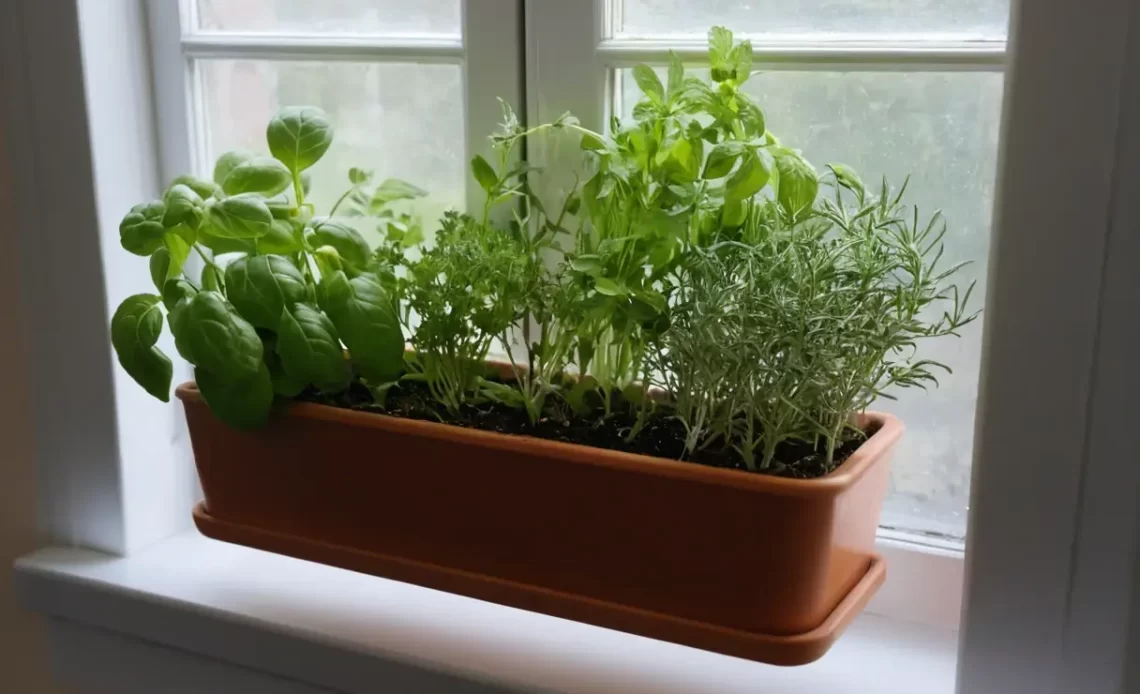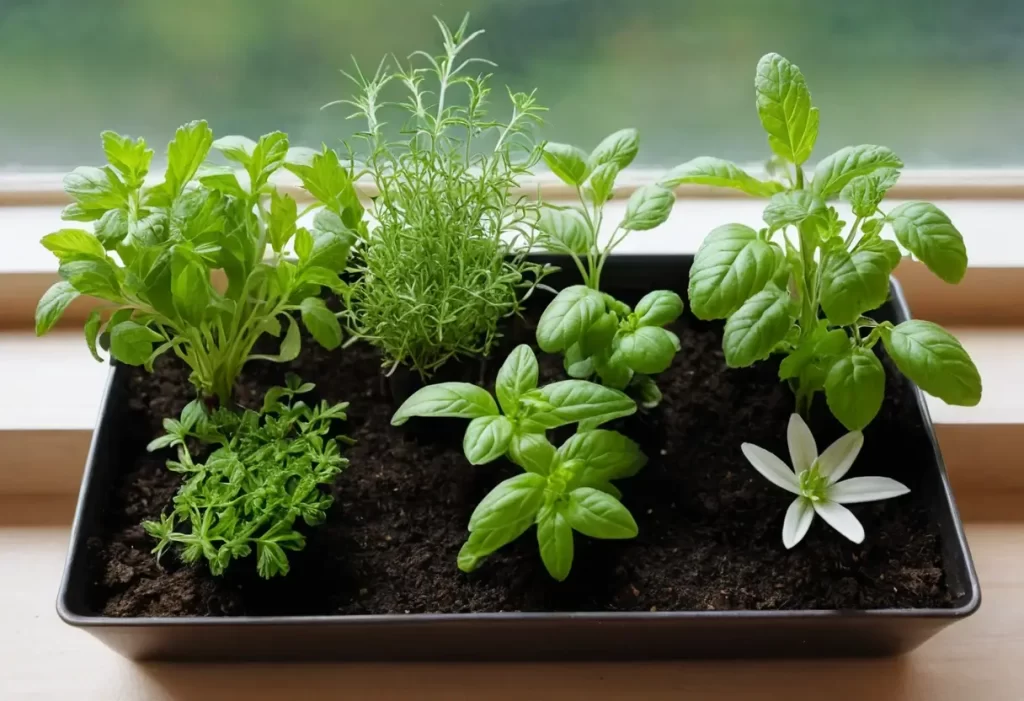
Growing herbs at home is a rewarding way to add fresh flavors to your meals without needing a large garden. Whether you have a small apartment, a balcony, or simply a windowsill, you can grow herbs in even the tiniest spaces. With a bit of planning and the right techniques, you can enjoy fresh herbs all year long. Here are some top tips to help you start growing herbs at home in small spaces, no matter the season.
Table of Contents
1. Choosing the Right Herbs for Small Spaces
When you’re working with limited space, it’s essential to choose herbs that will thrive in containers and adapt well to indoor or compact outdoor settings. Certain herbs are naturally better suited for small spaces due to their growth patterns and care requirements. Here are a few ideal choices:
- Basil: A popular kitchen herb, basil grows well in containers and is perfect for small spaces. Basil needs warm, sunny spots to thrive, so it’s ideal for a sunny windowsill or balcony.
- Parsley: Parsley can grow well indoors or outdoors in containers, and it doesn’t require as much sunlight as some other herbs. This makes it a great option if you have limited natural light.
- Mint: Mint is a hardy herb that can handle a bit of shade, but it tends to spread quickly. Growing mint in a container helps control its growth, making it easy to manage in small spaces.
- Chives: Chives are a low-maintenance herb that doesn’t require a lot of room to grow. They do well in small pots and add a mild onion flavor to many dishes.
- Thyme: Thyme is a compact herb that can be easily grown in a small container. It needs plenty of sunlight and is perfect for a sunny spot indoors or outside.
By selecting compact herbs that are easy to care for, you’ll have an easier time managing them in small spaces. Additionally, some herbs come in dwarf or mini varieties, which are especially suitable for container gardening.
2. Choosing Containers Wisely
The type of container you use can make a big difference in the success of your small-space herb garden. Since you’re growing herbs in a confined space, it’s essential to pick containers that provide adequate room for roots, along with proper drainage to prevent waterlogging.
Container Tips:
- Drainage: Select pots with holes at the bottom to allow proper drainage, which helps avoid overwatering and protects against root rot. If your container doesn’t have drainage holes, consider placing small stones at the bottom to help excess water drain away from the roots.
- Size Matters: While herbs don’t need huge pots, each herb should have enough room to grow. For individual herbs, small pots (about 4-6 inches in diameter) are often sufficient. For larger group plantings, a window box or rectangular container can work well.
- Vertical Gardening: If you’re limited on floor space, consider vertical planters or stackable containers. These space-saving options allow you to grow multiple herbs in a compact area, and they’re great for balconies or narrow indoor spaces.
Using the right containers helps your herbs thrive, even when growing herbs at home in a small area. Containers come in a variety of materials, including clay, plastic, and metal. Each material has different pros and cons, so consider what works best for your space and style.
3. Providing the Right Light
Light is one of the most important factors for growing herbs at home. Most herbs need at least 6 hours of sunlight daily to thrive, but when you’re working with small spaces, especially indoors, providing enough light can be a challenge.
Light Tips:
- Sunny Windowsills: Place your herbs near a sunny window that receives at least 6 hours of direct sunlight each day. South-facing windows usually provide the best light for indoor herbs, but east or west-facing windows can also work for lower-light herbs like mint or parsley.
- Grow Lights: If natural sunlight is limited, consider using grow lights to supplement. LED grow lights are energy-efficient and mimic natural sunlight, helping your herbs grow even in darker areas of your home.
- Rotate Plants: To ensure that all sides of the plant receive equal light, rotate your herb pots every few days. This helps prevent the plants from growing lopsided and encourages even growth.
Lighting plays a big role in keeping herbs healthy, so make adjustments as needed to keep your indoor garden well-lit. Even with limited space, proper lighting makes it possible to grow a wide variety of herbs.

4. Watering and Feeding
Growing herbs at home in containers requires regular care to keep the plants healthy. Unlike herbs grown in the ground, container plants dry out more quickly, especially indoors where air circulation is limited.
Watering Tips:
- Water Consistently: Herbs generally prefer soil that is moist but not soggy. Water your herbs once the top inch of soil feels dry to the touch. Use room-temperature water to avoid shocking the plants.
- Avoid Overwatering: Be careful not to overwater, as this can cause root rot, which is common in small containers. Herbs like thyme and rosemary are more drought-tolerant and don’t need as much water as basil or parsley.
Feeding Tips:
- Fertilizer: Herbs benefit from a light, balanced fertilizer every 4-6 weeks, especially if you’re growing them indoors. Use an organic fertilizer or one specifically designed for herbs. Be careful not to over-fertilize, as this can lead to excess leaf growth with less flavor.
Proper watering and feeding keep your herbs thriving in their small containers, allowing you to grow herbs year-round. With regular care, you’ll enjoy a continuous supply of fresh herbs for your kitchen.
5. Managing Space Efficiently
When growing herbs in tiny spaces, organization is key. Use creative solutions to maximize your available space without overcrowding the plants.
Space-Saving Ideas:
- Wall-Mounted Planters: Consider mounting small containers or shelves on a sunny wall in your kitchen or balcony. This vertical approach keeps your herbs accessible without taking up counter space.
- Compact Shelves: Small shelving units or tiered plant stands are great for fitting multiple herbs in one spot. Place the tallest plants on the top shelf and shorter plants below to ensure each plant gets enough light.
- Windowsill Gardens: Windowsills are perfect spots for compact herb gardens. Use a shallow container or a series of small pots to create a mini garden that won’t take up extra floor space.
By organizing your herbs carefully, you can maximize your space and keep your small herb garden tidy and functional.
6. Pruning and Harvesting for Continuous Growth
To keep your herbs healthy and productive, regular pruning and harvesting are essential. Pruning encourages new growth, which helps your herbs stay compact and prevents them from becoming too leggy or sparse.
Pruning Tips:
- Pinch Back Leaves: For herbs like basil and mint, pinch back the top leaves regularly to encourage the plant to grow fuller. Removing the top growth directs energy into producing new leaves.
- Harvest Frequently: Don’t be afraid to use your herbs! Frequent harvesting encourages new growth, which keeps your herbs fresh and flavorful.
Regular pruning and harvesting are key to growing herbs at home successfully. This keeps your plants in check and provides a steady supply of fresh leaves for cooking.
7. Protecting Herbs in Different Seasons
Growing herbs year-round in small spaces requires some attention to seasonal changes. For instance, many herbs may need extra care during the winter when light levels drop, and indoor heating can dry out the air.
Seasonal Tips:
- Winter Care: If your herbs are outdoors on a balcony, bring them inside during the winter. Place them in a bright, cool area and reduce watering slightly since herbs grow more slowly in colder months.
- Humidity: Indoor heating can dry out the air, so consider placing a small dish of water nearby or misting the plants occasionally to maintain humidity. A humidity tray filled with pebbles can also work.
By adjusting your care routines throughout the year, you can successfully grow herbs in small spaces no matter the season. With proper planning, your herb garden can flourish year-round, providing fresh ingredients for your kitchen.
Conclusion
Growing herbs at home in small spaces is a fun and practical way to bring fresh flavors into your cooking all year long. By choosing the right herbs, using suitable containers, providing enough light, and managing your space well, you can create a thriving herb garden no matter how limited your area may be. Remember to prune, harvest, and adjust your care routine as needed, and your herbs will reward you with a bountiful harvest. So, start small, stay consistent, and enjoy the journey of herb gardening right at home!

